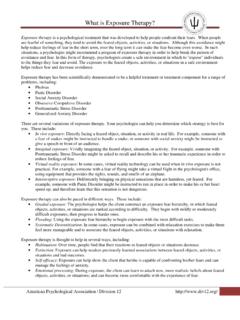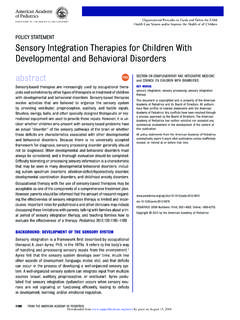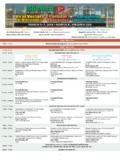Transcription of An Update on Empirically Validated Therapies
1 An Update on Empirically Validated TherapiesDianne L. Chambless, William C. Sanderson, VardaShoham, Suzanne Bennett Johnson, Kenneth S. Pope, PaulCrits-Christoph, Mary Baker, Benjamin Johnson, Sheila , Stanley Sue, Larry Beutler, David A. Williams, andSusan McCurryCorresponding author:Dianne L. Chambless, Dept. of Psychology, UNC-CH,Chapel Hill, NC : 919-962-3989, FAX: 919-962-2537,E-mail: Update on Empirically Validated TherapiesIn 1995 the Division 12 Task Force on Promotion andDissemination of Psychological Procedures published itsreport in this journal. A major focus of that report wasincreasing training in psychological interventions that havebeen supported in empirical research by making clinicalpsychologists and students more aware of these treatmentsand facilitating training opportunities. To provide the basisfor a survey on the degree to which clinical programs andinternships were currently providing training in empiricallysupported Therapies , the task force constructed a list ofexamples of treatments meeting criteria for efficacy asestablished by the task on feedback that members of the profession foundthis list of interventions to be very useful in training andclinical work, while also recognizing its very incompletebasis, the Division 12 board charged the succeeding taskforce (Task Force on Psychological Interventions), appointedin succession by Presidents Martin Seligman and GeraldKoocher, with adding to this preliminary list on an annualbasis.
2 This is one purpose of the current report. Inaddition, we raise several issues about the use andlimitations of Empirically supported treatments as currentlyidentified. In keeping with the practice established by thefirst task force, the members of the group who constructedthe present report are diverse in theoretical orientation andwork in a variety of settings -- psychology departments,medical schools, and private About the Use of the List of TreatmentsBecause the task force found that misinterpretations ofthe 1995 report abounded, particularly where the list ofexamples of Empirically Validated treatments (EVTs)1 wasconcerned, we begin this report with some caveats about theappropriate use of the updated list This list is intended to facilitate education byidentifying treatments with a scientific basis. This list is farfrom complete and should not be employed as the basis fordecisions concerning reimbursable treatments by third partypayers.
3 Although we will continue to Update the list insubsequent publications, it is beyond our resources to form acomplete catalogue, and emerging data would make any suchlist quickly out of date. That a treatment is not on our list inno way means that it has been shown to be list is particularly incomplete where children'sproblems and prevention programs are concerned. A separateDivision 12 task force constituted by President GeraldKoocher and chaired by Suzanne Bennett Johnson isfocusing on these issues. Moreover, there are areas of theliterature that are currently being examined by members ofthe task force who have not yet completed their reviews( , family therapy, treatment of alcoholism). Treatmentsfrom these areas will be considered in the next edition ofthis This list does not substitute for educators' andpractitioners' own decisions about what is the mostappropriate treatment for a given client. We have made norecommendations about what is the best treatment for aparticular problem.
4 The problem for which the client isseeking treatment is only one of the factors that need to beconsidered in selecting among treatment of manualized treatments to practice requireflexibility and adaptation to the requirements of each caseand We have drawn up this list based on criteria we reader may disagree. As part of the scientist-practitionertradition of clinical psychology, we would hope that clinicalprograms are training their students specifically in theevaluation of the efficacy of psychological interventions andthat postdoctoral practitioners continue to evaluatetreatments based on the empirical merits. In short, weencourage readers to use our list as a starting point, but tomake their own judgments. We have clarified our criteriasince the last task force report (1995) and hence include thetable of criteria again here. See Table particular the reader may wish to know how weresolved cases where there were conflicting data about theefficacy of a treatment.
5 Typically we relied on meta-analyses. When these were not available, we came to ajudgment based on the quality of the methodology acrosstrials and the preponderance of the important is what variables were tested in analysesof treatment efficacy. We concentrated on tests of change inthe defining problem or symptoms, although a number ofinvestigators also demonstrated improvement on broadertests of psychological functioning and quality of life. Thus,for example, if a study focused on treatment of alcoholismvia couples therapy, we did not consider the treatmentefficacious if marital satisfaction improved but alcohol-related problems did not. (Note that this study does provideadditional evidence for the efficacy of the treatment wheremarital discord is concerned.)4. Included in the current edition of the list are newentries as well as the original entries, which in some caseshave been modified on the basis of additional information orthe correction of errors.
6 New or modified entries are markedwith an asterisk in Table 2. We have organized Table 2 byproblem area and have identified which treatments we havefound that are effective for specific difficulties. (These werenot restricted to diagnoses, but could include any reliablyspecified problem for which a client might seek assistance.)We excepted token economy programs from the problem-specific restriction because the problem behaviors to whichtoken economies have been applied are legion (see Kazdin,1977).5. For treatments to be considered for this list, werequire that the supporting research have been conductedEMPIRICALLY Validated Therapies - Page 2with treatment manuals (with specific and rare exceptions).There are two reasons for this. First, it makes for betterresearch design and interpretable results. Second, it allowsreaders to know what the treatment actually entailed andtherefore what has been supported.
7 For example, there aremany types of dynamic therapy. When we indicate that briefdynamic therapy is probably efficacious as an adjunctivetreatment for opiate addition (Woody, Luborsky, McLellan,& O'Brien, 1990), we mean specifically the treatmentdescribed in the manual employed in that research, whichwas Supportive-Expressive Psychotherapy as adapted forsubstance abuse (Luborsky, Woody, Hole, & Vellecho,1995). Whether a very different type of dynamic therapylike Davanloo's (1980) would be effective remains to bestudied and should not be assumed. This is equally the casefor behavioral and cognitive Therapies . For example,relaxation training and exposure and response prevention areboth behavior Therapies , but the latter is significantly moreefficacious than the former in the treatment of obsessive-compulsive disorder (Rachman, Hodgson, & Marks, 1971).Thus, there are many interventions that fall under a rubric inthe table, and the brand names are not the critical manuals Depending on the problem treated, the psychologicalintervention cited in Table 2 may have been in addition toother treatment the patient received ( , medication forpsychotic patients, drug counseling, medical interventionsfor pain) or the sole treatment.
8 In case of the former wedetermined that the psychological intervention had a positiveimpact above and beyond the effects of the otherinterventions. In considering use of these treatments, thereader needs to consult the papers and manuals to determinewhen the psychological intervention should be consideredpart of a broader treatment Characteristics and the Interpretation of EVTF indingsDelivery of psychotherapy services and estimates of thelikelihood that a given EVT will be helpful to a particularclient are made difficult by the myriad potential variablesthat might affect a given client's response to treatment. Inthis section, we will consider two such broad areas ofconcern: using EVTs with ethnic minority clients andAptitude X Treatment of Ethnic Minority Clients Have EVTs been established for ethnic minoritypopulations? Analogue investigations aside, we know of nopsychotherapy treatment research that meets basic criteriaimportant for demonstrating treatment efficacy for ethnicminority populations -- namely, research in which (a) pre-and post treatment status is assessed for clients from one ormore ethnic minority group(s), (b) clients are blockedaccording to their particular ethnic group membership andrandomly assigned to different treatments or to treatment andcontrol groups, (c) multiple, culturally cross-validatedassessment instruments are employed, and (d) findings arereplicated (see Sue, 1995; Sue, Zane, & Young, 1994).
9 Thedearth of culturally cross- Validated measures makes evenbeginning such research the citations for EVTs identified in the 1995task force report, we find not a single study included tests ofthe efficacy of the treatment for ethnic minority investigators did not specify ethnicity of subjects orused only white subjects. Out of about 41 studies cited,only 6-7 made any reference to race or ethnicity of subjects( , DiMascio et al., 1979; Falloon et al., 1985; Foa et al.,1991; Hogarty et al., 1986; Mattick & Peters, 1988;Wilfley et al., 1990). Not one used ethnicity as a variable ofinterest. Recently, Chambless and Williams (1995)examined whether one EVT, in vivo exposure foragoraphobia, was as effective for African Americanoutpatients as for white ones. These preliminary datasuggested it was not. More research is clearly needed beforeconclusions can be drawn, but the point is that the data donot, at present, exist, or at least have not been implications can be drawn for research and practicewith ethnic minority populations?
10 Strictly speaking, then,the efficacy of EVTs has not been established with ethnicminority populations. This is unfortunate for severalreasons. First, the United States is among the most diversenations in the world, and most therapists will have to dealwith clients from very different cultural , there is indication that mental health needs of ethnicminority populations are high, and that these groups havebeen underserved or inappropriately served by the mentalhealth profession. Third, the lack of rigorous research on theefficacy of treatment for culturally diverse populations ispoor science because it shows a lack of attention to thelimits of generalization from the samples , those treatments that have been Validated for onepopulation may be valid for another. However, as scientists,we cannot assume that the effects will be similar. Outcomesmust be demonstrated by empirical research, especially inview of the controversies in the literature concerning thenecessity of considering cultural factors in treatment.








